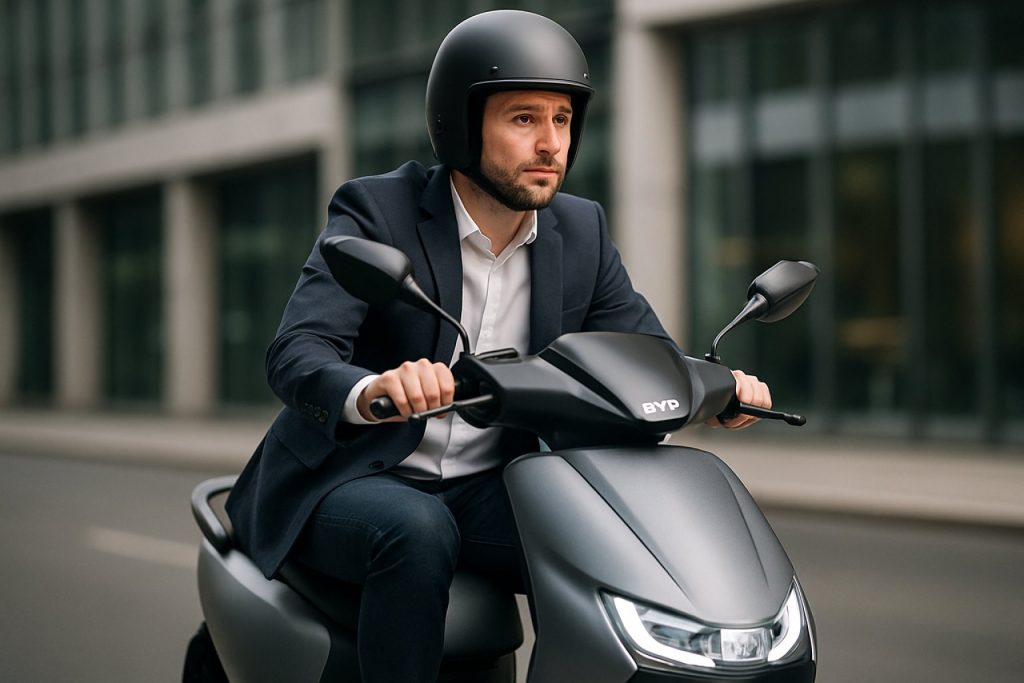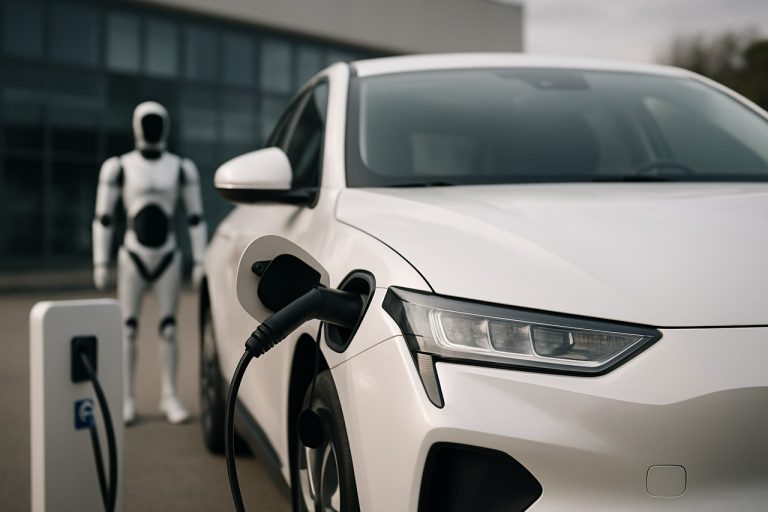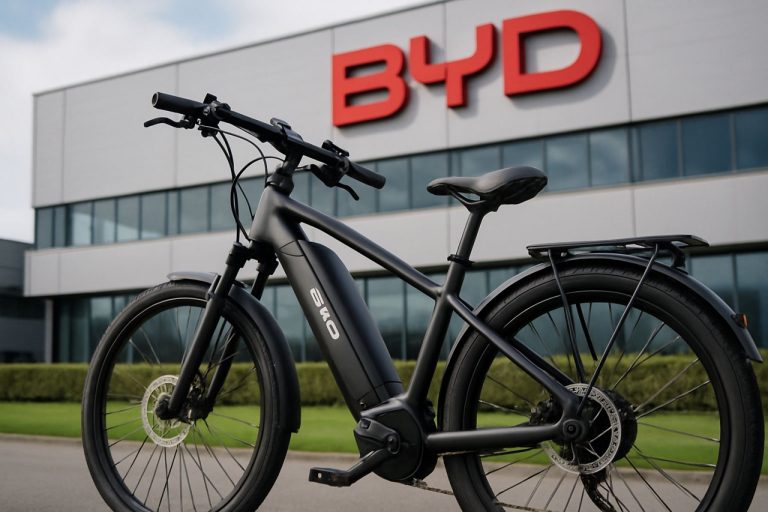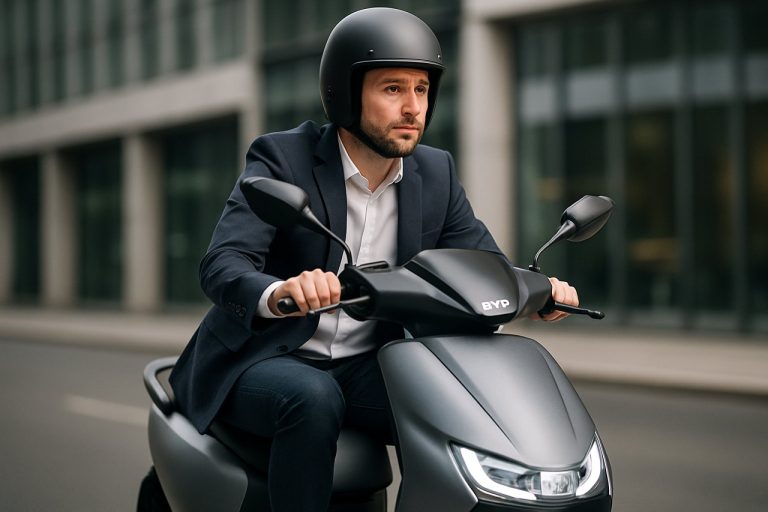
- The global electric two-wheeler market is booming, with over 70 million units shipped in 2024—China holds 80% of the share, making battery reliability crucial for millions of riders.
- BYD is entering the electric two- and three-wheeler battery sector, leveraging advanced lithium iron phosphate (LFP) “blade battery” technology known for safety, durability, and high performance.
- Upcoming regulations, including new national safety standards and a large-scale trade-in policy, are reshaping the industry and increasing demand for next-generation batteries.
- BYD’s in-house Battery Management System (BMS) offers real-time monitoring, promising longer battery lifespan and reduced risks for riders—especially full-time delivery workers.
- This shift favors major brands with strong R&D, promoting safer, smarter, and longer-lasting electric mobility solutions.
Rain taps on the painted eaves of a thousand courier kiosks across China, where delivery riders endure long shifts astride humming electric scooters. Their vehicles—essential yet humble—rely on batteries that too often fail before their prime, leaving riders frustrated and exposed to both downtime and danger. Now, the landscape is set for a seismic jolt: BYD, a maverick powerhouse in global electric vehicles, is surging into the two- and three-wheel battery business with ambitions as vast as the market itself.
The stakes are monumental. In 2024, the world’s electric two-wheeler shipments will tick past 70 million units, a figure that casts a long shadow over the automobile market. China claims a staggering 80% of this share, while Southeast Asia and Africa boast some of the fastest growth rates. For perspective, China’s two-wheeler market alone racks up nearly 50 million sales annually, with over 400 million units already in circulation. It’s a colossus—a market not just for vehicles, but for the batteries that power them, which typically cry out for replacement every 3 to 5 years.
This isn’t BYD’s first dance with electric two-wheelers. Back in 2020, the company discreetly supplied lithium batteries to Didi’s Qingju brand and forged alliances with top-tier manufacturers like Tailg. These maneuvers weren’t momentary diversions—they were careful dress rehearsals, laying the groundwork for a debut from backstage supplier to headlining disruptor.
The timing is no accident. Regulatory floodgates are opening. August 2024 will see a nationwide “trade-in” policy encouraging riders to upgrade their aging bikes—itself a pointer to the market’s maturity and a moment ripe for next-generation technology. Stringent safety standards, soon to be enforced under the new “GB 17761—2024” national guideline, now demand real, automotive-grade solutions to chronic issues of battery safety, lifespan, and reliability. If ever there was a call for industry-level recalibration, it’s now.
BYD responds with formidable clout. The company unveiled its two-wheeler lithium iron phosphate (LFP) battery system—a distillation of the legendary “blade battery” technology that powers its electric cars. Known for exceptional safety, longevity, and intelligence, these batteries come armed with an in-house Battery Management System (BMS) capable of real-time monitoring down to the cell level. This isn’t just a step up—it’s a leap, especially when compared with the patchwork quality and volatility of traditional lead-acid cells.
Such a technological leap isn’t merely about dominance—it raises the competitive bar for the entire sector. Reputable brands with deep pockets and robust R&D may rise, while smaller players risk getting squeezed out or relegated to contract manufacturing. Suddenly, the market’s focus shifts from bargain-bin pricing to long-term value, durability, and above all, peace of mind. For millions of consumers, especially the unsung heroes delivering meals and goods across sprawling urban landscapes, the impact could be profound. Consider that full-time delivery riders often cover more than 300 kilometers daily. Inadequate batteries, forced downtime for swapping or charging, and, at times, catastrophic fires have turned their work into a risky venture. Improved technology doesn’t just mean better business—it could mean safer livelihoods.
The message whispers through China’s bustling streets and surges outwards: an industry once content with mediocrity now stands at the threshold of transformation. With BYD steering the current, the ride may become not only longer, but markedly safer and smarter.
The takeaway? The electric two-wheeler revolution is no longer a side note—it is front and center. Whether you’re a rider, a commuter, or simply a believer in safer, greener cities, keep your eyes on the road ahead. The status quo is officially in jeopardy.
For ongoing developments in electric vehicles, visit BYD and Didi.
BYD’s Battery Revolution: How Smarter Power is Supercharging China’s Electric Scooter Industry—And What It Means for the World
Introduction
The electric two-wheeler market is on the brink of a major transformation, with BYD’s entry into the sector set to reshape benchmarks in safety, longevity, and performance. The stakes are enormous: hundreds of millions of scooters zoom through China’s streets daily, supporting the livelihoods of delivery workers who rely on reliable, safe batteries. Yet, the real story behind BYD’s strategic push goes far beyond what most headlines reveal.
Expanded Context—China’s Dominance and Market Evolution
Global Market Insights:
– Massive Volume: China alone accounts for roughly 80% of worldwide electric two-wheeler shipments (nearly 50 million units annually, per [Statista](https://www.statista.com)).
– Explosive Growth Beyond China: Southeast Asia and Africa are registering double-digit annual growth rates, with increasing demand for cleaner, affordable mobility solutions.
– Battery Replacement Cycle: With over 400 million two-wheelers in China, and batteries needing replacement every 3-5 years, the battery aftermarket represents a huge, recurring revenue stream.
Regulatory Game-Changers:
– GB 17761—2024 Standards: These new regulations will enforce stricter rules on battery safety, reliability, and lifespan, phasing out subpar lead-acid solutions and driving adoption of automotive-grade lithium batteries.
– Government Buy-Backs: The August 2024 “trade-in” policy incentivizes consumers to upgrade to safer, more efficient rides—expanding demand for high-quality batteries.
BYD’s Battery Innovation—E-E-A-T Deep Dive
Lithium Iron Phosphate Blade Batteries:
– Safety First: LFP chemistry is less prone to thermal runaway and fire compared to nickel-manganese-cobalt (NMC) or traditional lead-acid batteries. The “blade” form factor furthers thermal stability—crucial for scooter batteries exposed to rough real-world handling.
– Long Life Cycle: Blade batteries can last 8-10 years (up to 3,000 charge-discharge cycles), far exceeding the 2-3 years typical of standard scooter batteries. This slashes battery replacement costs for riders and fleet operators.
– Intelligent BMS Integration: BYD’s proprietary Battery Management System provides real-time diagnostics, predictive maintenance, and cell-level safety shutdowns—features generally absent in current low-cost batteries.
Real-World Use Cases:
– Courier Fleets: Delivery companies like Meituan and Ele.me—serving millions of daily food orders—can reduce downtime and replacement logistics with longer-lived, safer batteries.
– Commuter Adaptation: Extended daily ranges, rapid charging, and long battery life encourage more consumers to switch from gas scooters or public transit.
Compatibility & Tutorials:
– Plug-and-Play Retrofitting: Many new batteries are designed to retrofit existing scooters, making upgrades feasible even for current owners. BYD’s system supports fast swaps—ideal for shared and ride-hailing fleets.
Industry Impact—Trends and Forecasts
Market Disruption:
– Shift to Lithium: Analysts from BloombergNEF predict that, by 2027, lithium batteries will outpace lead-acid in two-wheeler OEM sales due to falling costs and regulatory mandates.
– Competitive Squeeze: With BYD’s entry, smaller battery makers face heightened pressure; consolidation and contract manufacturing partnerships are likely.
Security & Sustainability:
– Resource Efficiency: LFP chemistry avoids cobalt and nickel—reducing ethical and environmental concerns associated with their mining.
– Circular Economy: Large players like BYD are piloting battery recycling programs to reclaim lithium and reduce e-waste.
Pros & Cons Overview
Pros:
– Substantial safety improvements (fire and explosion resistant)
– Long cycle life, reducing TCO (total cost of ownership)
– Real-time monitoring and predictive maintenance
– Lower environmental impact (no heavy metals)
Cons:
– Initial cost premium over basic lead-acid batteries
– Upgrading legacy scooters may require some technical adaptation
Limitations & Controversies
– Battery Swapping Model: While BYD’s battery longevity reduces the urgency for swapping, other startups (e.g., Gogoro) emphasize swappable battery stations—raising debates over which model will dominate in urban settings.
– E-Waste Concerns: The sheer volume of old lead-acid batteries being retired could strain recycling infrastructure if not managed proactively.
– Affordability Gap: Rural and low-income consumers may face short-term costs in shifting to higher-grade batteries.
Reviews & Comparisons
– BYD vs. CATL, CALB: While CATL supplies batteries to Tesla and Nio, BYD’s vertically integrated model (vehicles + batteries) may offer cost and reliability advantages for mass-market scooter applications.
– User Feedback: Early pilots in Didi’s Qingju fleet showed robust performance, with reduced downtime and higher user satisfaction compared to lead-acid systems.
Pressing Reader Questions—Expert Answers
Q: Is the new BYD battery compatible with all older scooters?
A: Most modern models will accept BYD’s new battery modules, but some older or non-standard scooters may need retrofit kits. Consult brand-certified service centers.
Q: How does BYD’s pricing compare to old lead-acid batteries?
A: BYD’s LFP batteries may cost 50–70% more upfront, but the payoff is a life cycle that’s double or triple and substantially lower maintenance costs over time.
Q: Will these batteries work in Southeast Asian and African climates?
A: LFP chemistry performs well in hot, humid conditions, a key advantage for tropical markets where lead-acid batteries degrade quickly.
Q: Are there risks of supply shortages?
A: With BYD’s global manufacturing scale, supply constraints are less likely—but rapid market adoption could cause short-term bottlenecks.
For further official updates visit BYD and Didi.
—
Actionable Recommendations & Quick Tips
1. Riders: If your electric scooter battery is over 3 years old, begin researching LFP upgrade options and government incentives—especially before the August 2024 “trade-in” boom.
2. Fleet operators: Consider partnering directly with BYD or certified dealers to secure priority for bulk orders and after-sales support.
3. Safety First: Only use certified OEM batteries; avoid aftermarket solutions of dubious origin, as fire risks and regulatory compliance are now strict.
4. Recycling: Leverage government battery return programs—proper recycling is now widely available and often rewarded.
—
Quick Life Hack
– Boost Battery Longevity: Charge between 20%–80% of capacity for daily use to maximize cell lifespan—avoiding full charge/discharge cycles helps even with advanced LFP batteries.
—
Conclusion
BYD’s push into the two- and three-wheeler battery market is a long-overdue jolt the industry badly needed. With stricter safety standards, technological leapfrogging, and a sharpened focus on sustainability, millions of urban riders and the planet itself stand to benefit. The electric two-wheeler revolution is now center stage—and with smart preparation, both businesses and individuals can ride the wave to safer, greener, and more cost-effective mobility.



